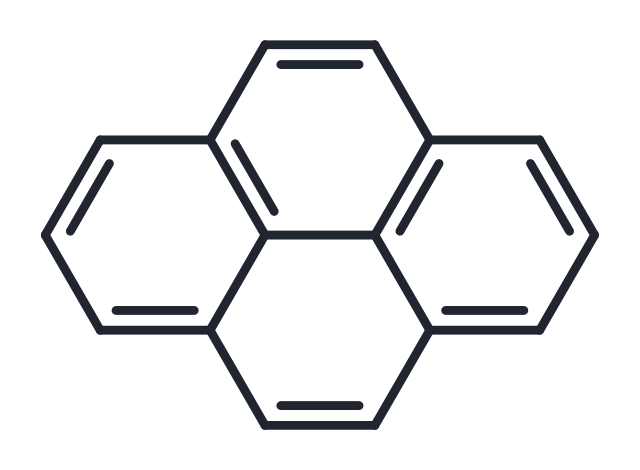- Remove All
 Your shopping cart is currently empty
Your shopping cart is currently empty
Shopping Cart
Pyrene
Catalog No. T200798Cas No. 129-00-0
Pyrene, a polycyclic aromatic hydrocarbon (PAH), consists of four fused benzene rings. It exhibits a distinct aromatic odor and originates from the incomplete combustion of organic matter. Notably, Pyrene demonstrates strong fluorescence, emitting in the blue region of the spectrum, which enables its use as a probe for studying molecular interactions in solutions and on surfaces. It is also utilized as a model compound for researching polycyclic aromatic hydrocarbons in various environmental and biological systems due to its ubiquitous presence. However, prolonged exposure to Pyrene is associated with potential health risks, including carcinogenic and mutagenic effects.

Pyrene
Catalog No. T200798Cas No. 129-00-0
Pyrene, a polycyclic aromatic hydrocarbon (PAH), consists of four fused benzene rings. It exhibits a distinct aromatic odor and originates from the incomplete combustion of organic matter. Notably, Pyrene demonstrates strong fluorescence, emitting in the blue region of the spectrum, which enables its use as a probe for studying molecular interactions in solutions and on surfaces. It is also utilized as a model compound for researching polycyclic aromatic hydrocarbons in various environmental and biological systems due to its ubiquitous presence. However, prolonged exposure to Pyrene is associated with potential health risks, including carcinogenic and mutagenic effects.
| Pack Size | Price | Availability | Quantity |
|---|---|---|---|
| 10 mg | Inquiry | Backorder | |
| 50 mg | Inquiry | Backorder |
Bulk & Custom
Add to Cart
Questions
View MoreContact us for more batch information
Resource Download
Product Introduction
Bioactivity
Chemical Properties
| Description | Pyrene, a polycyclic aromatic hydrocarbon (PAH), consists of four fused benzene rings. It exhibits a distinct aromatic odor and originates from the incomplete combustion of organic matter. Notably, Pyrene demonstrates strong fluorescence, emitting in the blue region of the spectrum, which enables its use as a probe for studying molecular interactions in solutions and on surfaces. It is also utilized as a model compound for researching polycyclic aromatic hydrocarbons in various environmental and biological systems due to its ubiquitous presence. However, prolonged exposure to Pyrene is associated with potential health risks, including carcinogenic and mutagenic effects. |
| Molecular Weight | 202.25 |
| Formula | C16H10 |
| Cas No. | 129-00-0 |
Storage & Solubility Information
| Storage | Powder: -20°C for 3 years | In solvent: -80°C for 1 year | Shipping with blue ice. |
Calculator
In Vivo Formulation Calculator (Clear solution)
Please enter your animal experiment information in the following box and click Calculate to obtain the mother liquor preparation method and in vivo formula preparation method:
Mother liquor preparation method: 2 mg of drug dissolved in 50 μL DMSO (mother liquor concentration of 40 mg/mL), if you need to configure a concentration that exceeds the solubility of the product, please contact us first.
(mother liquor concentration of 40 mg/mL), if you need to configure a concentration that exceeds the solubility of the product, please contact us first.
Preparation method for in vivo formula: Take 50 μL DMSO main solution, add 300 μLPEG300
main solution, add 300 μLPEG300 mix well and clarify, then add 50 more μL Tween 80, mix well and clarify, then add 600 more μLddH2O
mix well and clarify, then add 50 more μL Tween 80, mix well and clarify, then add 600 more μLddH2O mix well and clarify
mix well and clarify
For Reference Only. Please develop an appropriate dissolution method based on your laboratory animals and route of administration.
Dose Conversion
You can also refer to dose conversion for different animals. More Dose Conversion
Tech Support
Please see Inhibitor Handling Instructions for more frequently ask questions. Topics include: how to prepare stock solutions, how to store products, and cautions on cell-based assays & animal experiments, etc
Related Tags: buy Pyrene | purchase Pyrene | Pyrene cost | order Pyrene | Pyrene chemical structure | Pyrene formula | Pyrene molecular weight

Copyright © 2015-2025 TargetMol Chemicals Inc. All Rights Reserved.




